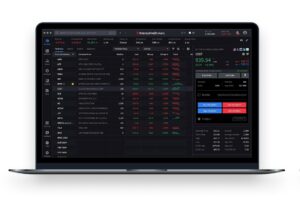At the end of Wednesday, the Dow Jones Index (US30) fell by 1.73%. The S&P 500 Index (US500) was down 2.24%. The Nasdaq Technology Index (US100) lost 3.04%. Wall Street faced a broad sell-off on Wednesday, led by a sharp drop in technology stocks amid escalating trade tensions and cautious remarks from Federal Reserve Chairman Jerome Powell. Nvidia fell by 6.9% after the chipmaker said it will have to pay $5.5 billion because of new restrictions on US exports of artificial intelligence chips destined for China. Other chipmakers followed: AMD (-7.3%) and Micron Technology (-2.4%) fell amid cost warnings and weak demand. Powell’s speech in Chicago added to market worries, warning that tariffs could push up inflation and slow growth, creating a dilemma for the Fed’s dual mandate. Investors were frustrated by the lack of a clear signal of future rate cuts, causing major indexes to fall to session lows.
The Bank of Canada kept its benchmark rate at 2.75%, its first pause after a cumulative 2.25 percentage point cut over seven meetings, citing the unclear outlook for tariffs in the US, which could either support solid growth with inflation near 2% or, if tariffs intensify, trigger a recession and higher inflation. This cautious stance has reinforced expectations of stable monetary policy in Canada, which has supported the Canadian dollar, while the US dollar is weakening under the weight of potential new tariffs on critical minerals, adding further uncertainty to the US growth outlook.
The World Trade Organization (WTO) warned that global trade could contract by 1.5% in 2025 if Donald Trump’s aggressive tariff policies cause widespread trade uncertainty, in sharp contrast to the previous expectations of 2.7% growth.
Equity markets in Europe were mostly up yesterday. Germany’s DAX (DE40) rose by 0.27%, France’s CAC 40 (FR40) closed 0.07% higher, Spain’s IBEX 35 (ES35) added 0.49%, and the UK’s FTSE 100 (UK100) closed positive 0.32%.
WTI crude oil prices hit $63 per barrel as new US sanctions against Chinese importers of Iranian oil renewed supply concerns. The sanctions are aimed at reducing Iran’s oil exports as nuclear talks resume, fueling fears of dwindling global supplies. Prices were further supported by an OPEC report that Iraq, Kazakhstan, and other countries are planning additional production cuts to offset previous overproduction.
Asian markets were predominantly falling yesterday. Japan’s Nikkei 225 (JP225) was down 1.01%, China’s FTSE China A50 (CHA50) added 0.48%, Hong Kong’s Hang Seng (HK50) was down 1.91%, and Australia’s ASX 200 (AU200) was negative 0.04%.
New Zealand’s annualized inflation rate rose to 2.5% in the first quarter, slightly above market expectations of 2.3%, up from 2.2% in the previous quarter. Despite the rise, the rate was within the Reserve Bank of New Zealand’s target range of 1-3% for the third consecutive quarter, reinforcing the view that this will not prevent further rate cuts. Markets still expect another 25bp rate cut at the next RBNZ meeting in May, with rates likely to reach the 2.75% level by the end of the year.
On Thursday, the Australian dollar slipped to USD 0.635, breaking a six-day winning streak, as weaker-than-expected employment data fueled expectations of further monetary easing by the Reserve Bank of Australia. While the unemployment rate remained at a low 4.1%, employment growth in March came in below expectations. This boosted bets that the RBA would cut interest rates by 25 basis points in May, with some even speculating a possible 50 basis point hike amid growing fears of a tariff-induced slowdown in the global economy.









